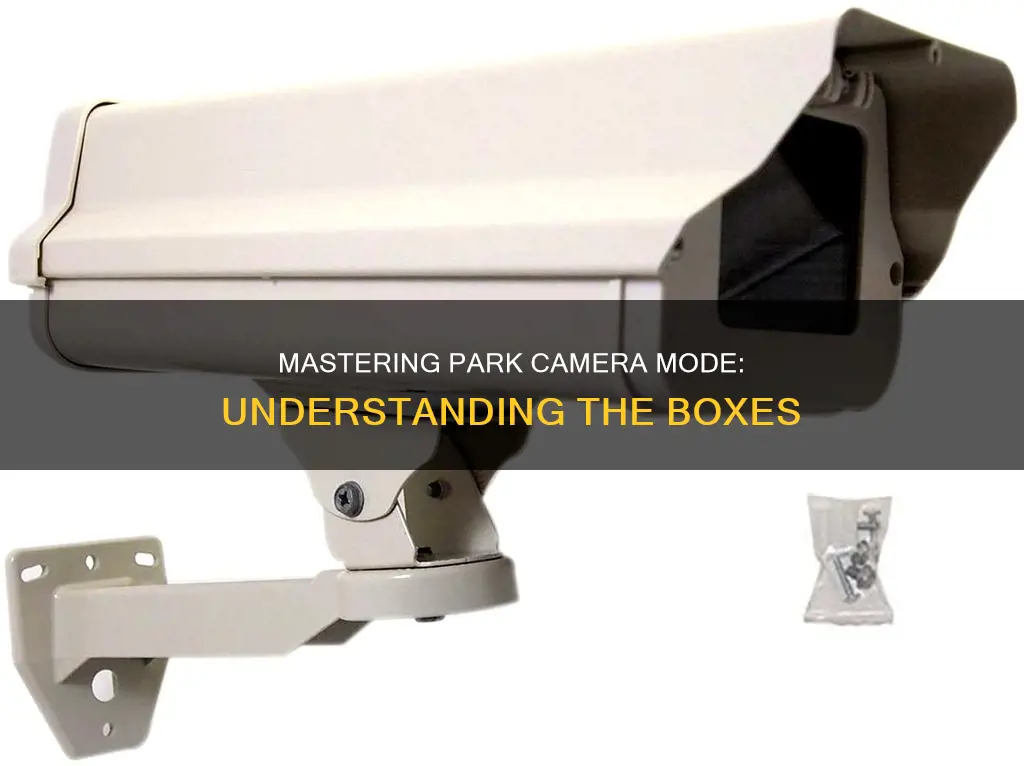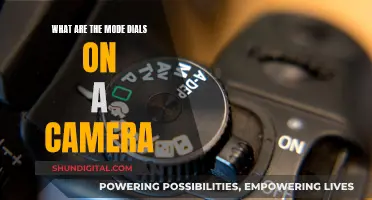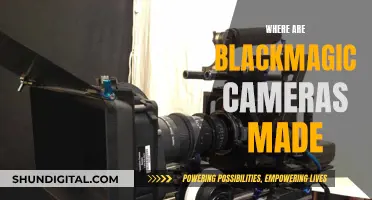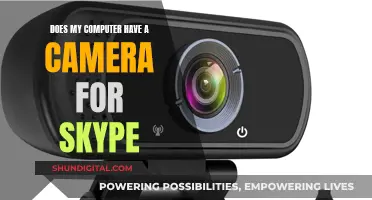
Dash cams are primarily designed to record your drive, but some can also monitor your car when it's parked through a feature called Parking Mode. This feature is useful if you're worried about hit-and-runs or vandalism on your parked vehicle. Parking Mode is activated when the ignition is turned off and the car is stationary, and the camera will only start recording if it detects motion or impact. This means that your dash cam minimises the risk of overwriting important footage and reduces stress on the microSD card, which helps extend its lifespan.
| Characteristics | Values |
|---|---|
| Purpose | Monitor your car when you are away |
| Use | Protection against hit-and-runs or vandalism |
| Activation | When the ignition is turned off |
| Recording | Only when an event happens that's worth recording |
| Event | An impact that triggers the camera's G-sensor or motion detected visually or by radar |
| Power source | Hardwire kits, OBD-II power cables, or dash cam battery packs |
What You'll Learn
- Buffered parking mode: The camera records continuously, saving footage to its memory. When an impact or motion is detected, a video clip is saved to the SD card
- Time-lapse mode: The camera shoots a still picture every second, allowing you to watch a time-lapse of what happened around your car while you were away
- Low bit rate mode: The camera runs continuously but records at a lower video quality and resolution
- Radar parking mode: The camera detects motion and prepares to save an event clip. If an impact is detected, a 20-second video is saved
- Impact and motion detection: The camera detects an impact or motion and starts recording

Buffered parking mode: The camera records continuously, saving footage to its memory. When an impact or motion is detected, a video clip is saved to the SD card
Buffered Parking Mode: The Benefits
Buffered parking mode is an advanced feature offered by premium dash cams, providing continuous recording and added protection for your vehicle. Here's how it works and why it matters:
How Buffered Parking Mode Works
Buffered parking mode is a smart way to ensure your dash cam captures crucial footage without filling up your SD card. In this mode, the camera records continuously, saving the footage to its internal memory (RAM). This means that even when your car is parked and inactive, the camera is always on guard.
However, it only saves events to the SD card when it detects motion or impact. Typically, the camera will save a video clip that starts a few seconds before the event and ends a few seconds after, ensuring you get the full context of what happened. This way, you have a much better chance of identifying anyone or anything that damaged your vehicle.
The Advantages of Buffered Parking Mode
Buffered parking mode offers several advantages over other parking surveillance options:
- Full Contextual Footage: Unlike simple parking mode, which only records after an impact is detected, buffered parking mode captures the moments leading up to an incident. This can provide valuable evidence, especially in hit-and-run cases.
- Efficient Memory Usage: By saving only relevant clips to the SD card, buffered parking mode prevents your memory card from filling up with useless files. This means you won't have to worry about deleting old footage to make space for new recordings.
- Reduced Power Consumption: While the camera is always recording, buffered parking mode is still more energy-efficient than time-lapse mode. This is because it only needs to write to the SD card when an event is detected, which reduces power draw.
- Reliability: Buffered parking mode ensures that you capture the critical moments, even if the impact or motion occurs suddenly. This reliability can make all the difference when you need evidence for insurance claims or legal purposes.
Drawbacks and Considerations
While buffered parking mode is a powerful tool, it's not without its drawbacks. Here are some considerations:
- Memory Limitations: The amount of footage that can be stored in the camera's internal memory is limited. If the camera's memory fills up before an event is detected and saved to the SD card, older footage will be overwritten.
- Power Requirements: To take full advantage of buffered parking mode, your dash cam will need a constant power source when the engine is off. This usually means hardwiring the camera to your vehicle's battery or using an external battery pack.
- Cost: Buffered parking mode is typically a feature of premium dash cams, which tend to be more expensive. Additionally, you may need to invest in accessories like hardwiring kits or battery packs to use this mode effectively.
Buffered parking mode is an excellent choice if you're looking for comprehensive parking surveillance for your vehicle. It strikes a balance between continuous recording and efficient memory usage, ensuring you capture crucial events without wasting storage space. While it requires some investment in equipment and setup, the added protection it offers can provide peace of mind and valuable evidence in the event of an incident.
Vivint Doorbell Camera: Where's the Battery?
You may want to see also

Time-lapse mode: The camera shoots a still picture every second, allowing you to watch a time-lapse of what happened around your car while you were away
Time-lapse mode is a feature of some dash cams that allows you to monitor your vehicle when it is parked and the engine is off. The camera shoots a still picture every second, and these photos are then strung together to create a time-lapse video of what happened around your car while you were away. This is a useful feature if you want to keep an eye on your car but don't want to use up too much storage space.
Time-lapse mode is a good option if you want to monitor your car in a busy area with lots of vehicle and foot traffic. It also comes in handy if you only have a small-capacity microSD card, as it takes up less space than regular video footage.
To use time-lapse mode, you will need to connect your dash cam to your vehicle's battery or a battery pack to provide power when the engine is off. You can do this using a hardwire kit or an external battery pack. Keep in mind that time-lapse mode may drain your car's battery more quickly, so you may need to take steps to keep your battery topped up or consider a battery pack as a more reliable power source.
When choosing a dash cam with time-lapse mode, look for one that has good video quality, is discreet, and is reliable. You may also want to opt for a dual-channel dash cam to increase your field of view and improve your chances of capturing any incidents. Additionally, make sure to get a memory card that is made for heavy use and can handle time-lapse footage.
Overall, time-lapse mode is a valuable feature for vehicle owners who want to keep their cars under surveillance when parked. It provides a quick overview of everything that happens around your car, helping you stay informed and giving you peace of mind.
Finding Camera Raw Preferences: A Quick Guide
You may want to see also

Low bit rate mode: The camera runs continuously but records at a lower video quality and resolution
Low bit rate mode is a feature that allows a camera to record continuously while parked, without overwriting the memory card. This is achieved by reducing the bitrate, which is the amount of data processed per second when recording footage. A lower bitrate results in lower video quality and resolution but enables more extended continuous recording times.
The bitrate determines the amount of processing power needed to record or play back video. It is the speed at which the camera can update the pixels in each frame. While resolution refers to the maximum possible number of pixels in a still image, the bitrate refers to the speed at which these pixels can be updated. A camera with a high-resolution sensor but a low bitrate processor will only be able to update some of the pixels each frame, resulting in lower video quality.
The VIOFO A129 Pro Duo dashcam, for example, includes a low bitrate recording feature when hardwired directly into a car's electrical system. This feature reduces the bitrate to just 4 Mb/s, allowing the camera to record video and audio continuously while parked for extended periods.
The trade-off with a lower bitrate is that the video quality will be lower, and there may be more digital artifacts or distortions in the footage. However, this mode can be useful when continuous recording is a higher priority than video quality, such as when using a camera for security or surveillance purposes.
GoPro Charging Time: How Long Until Your Camera's Ready?
You may want to see also

Radar parking mode: The camera detects motion and prepares to save an event clip. If an impact is detected, a 20-second video is saved
Radar parking mode is an advanced feature offered by Thinkware dash cams. It is comparable to buffered parking mode but requires much less energy. In fact, it can run for up to 40 days if the dash cam is powered by a battery pack.
In Radar parking mode, the camera detects motion and prepares to save an event clip. If an impact is detected, a 20-second video is saved, consisting of 10 seconds of footage before the impact and 10 seconds after. If no impact is detected, the camera resumes its Energy Saving Mode.
The Radar Module uses Lidar to detect a sedan or larger-sized object moving near your parked vehicle and will begin recording. The detection distance range is approximately 7m (23ft), with a horizontal angle range of 80° and a vertical angle range of 35°.
To enable Radar parking mode, you need to pair the Radar Module accessory (sold separately) with a Thinkware dash cam model such as the U1000, Q1000, or X1000. You also need to ensure that Energy Saving Mode 2.0 is turned on.
Radar parking mode is a great choice if you plan on parking your vehicle for an extended period. It provides peace of mind and security, allowing you to monitor any impacts or motion around your vehicle while it is parked.
Long Exposures: How They Affect Your Camera's Battery Life
You may want to see also

Impact and motion detection: The camera detects an impact or motion and starts recording
Impact and Motion Detection
Impact and motion detection is a feature in dash cams that are built with a G-sensor, which is an accelerometer that registers information based on the amount of force delivered when an impact is detected by your camera. When a predetermined value is reached by the G-sensor, the dash cam footage automatically gets saved and relocated to a special folder for safekeeping, bookmarked for later. This gives you peace of mind, knowing that when an accident or collision happens, files are protected as guaranteed evidence, and easy to find afterwards.
Motion detection, on the other hand, uses video sensor analysis algorithms to distinguish between relevant motions. This will be able to determine which motion footage is far off in the background, or nearby your car, ensuring the close ones are saved and recorded. Compared to impact detection, motion detection works more as a silent witness that documents any suspicious behaviour around the vicinity of your vehicle, specifically while parked. Impact detection is best for scenarios where your vehicle is hit, and motion detection works best in the events of theft, vandalism, or keying.
When you leave your car unattended, activating the parking mode feature of your dash cam safeguards your vehicle with another layer of protection. Impact and motion detection provides drivers with peace of mind that whether it’s a hit-and-run, a thief trying to break in or pass by, the dash cam will record and save the evidence, all organised in their respective folders. This gives users the convenience of searching for the files they need when the situation calls for it.
Motion detection, of course, will only pick up recordings of what passes in front of the camera, while impact detection will ensure even if there is an impact to the side of the vehicle, the camera is wide awake to capture even the smallest details that pass by.
Buffered Recording Mode
Beyond impact and motion detection, another must-have parking mode feature is buffered recording. While knowing what happened after an incident is important, it’s also important to see the incident itself, and what caused it. In buffered parking mode, dashcams record a video sequence (typically starting 15 seconds before the event and finishing 30 seconds after the event) so you get the full picture. Just like impact and motion detection, files captured during buffered recording get automatically saved into the micro SD card when an event is detected.
Modern dash cams from Thinkware, BlackVue, and VIOFO are equipped with these recording features. However, Thinkware has the most advanced parking mode settings, which also includes cutting-edge surveillance features such as Energy Saving Parking Mode and Smart Parking Mode.
Charging Camera Batteries: How Frequently Should You Do It?
You may want to see also
Frequently asked questions
Parking mode is a feature of some dash cams that allows them to monitor your car when it is parked and the engine is off. This provides 24/7 surveillance of your vehicle, which is useful in the case of hit-and-runs or vandalism.
Parking mode is activated when the ignition is turned off and the vehicle is stationary. The dash cam will then detect any impact or motion, and start recording to capture the incident.
Parking mode provides peace of mind by offering around-the-clock protection for your vehicle. It can help you identify and catch perpetrators in the event of vandalism or hit-and-runs.
There are several types of parking modes, including Simple (impact or event-activated), Buffered (continuous recording with clips saved to SD card upon impact or motion), Time-Lapse (captures still pictures at regular intervals), Low Bit Rate (continuous recording at lower video quality), and Radar (advanced motion detection with reduced power consumption).
You can use a hardwiring kit to connect the dash cam to your car's fuse box, or install an external battery pack to power the dash cam. These options ensure a continuous power supply without draining your car's battery.







